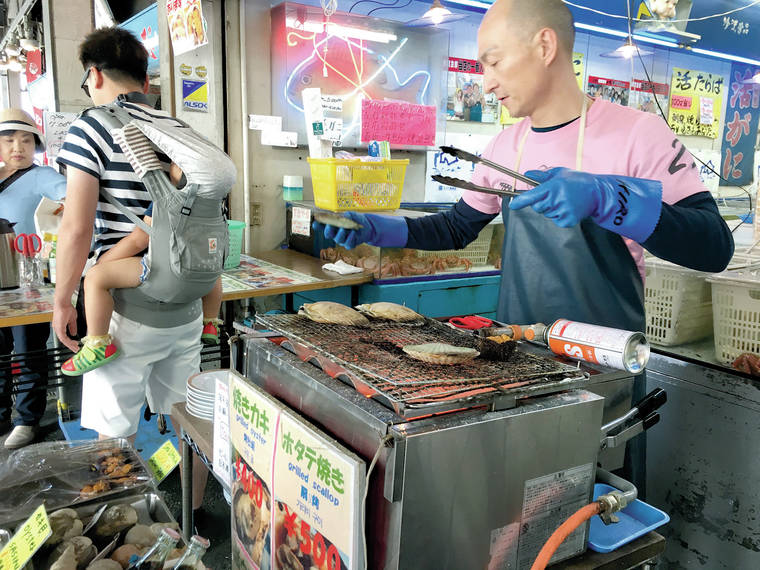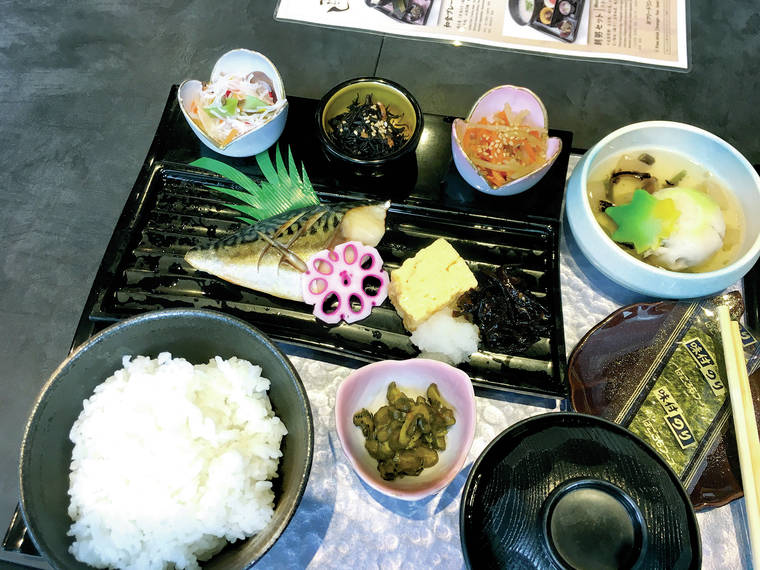One of my favorite meals in Japan is breakfast.
Most hotels offer it as part of staying with them, often giving out breakfast coupons when you check in. The selections are mostly an assortment of vegetables prepared in different ways. A green salad is always served, with sliced tomatoes and other fresh cut vegetables. Often there is miso soup, but in Hokkaido, which is not known for its miso, the soup might be pumpkin instead. The fish, usually broiled, are small, 1-2 ounces in size.
The hotel where we stayed in Hokkaido offered a buffet consisting of absolutely delicious packages of natto, spinach shirai, nishime, gobo and carrot nitsuke, prepared hijiki, chicken curry, steamed pumpkin, a large assortment of tsukemono (or pickled vegetables), broiled fish (either salmon or saba), scrambled eggs, pumpkin soup rice mixed with bamboo shoots and plain white rice. As hard as you try to eat it all, it is nearly impossible.
After a few days, I picked out my favorites, which were mostly vegetables. The rice is so good there, very different from the rice we get here. There is so much pride in the growing of rice and at a market, I saw pictures of the farmers as part of the rice label.
The next day, the breakfast changed to fried chives and eggs, kimpira, seaweed salad, gagome seaweed, along with the tsukemono.
At the hotel in Tokyo, the breakfast was a choice of Japanese, Western, morning porridge or Kyoto style, with udon noodles in hot broth. I chose the Japanese breakfast, which consisted of miso soup with mushrooms and “fu,” grilled fish (which changed daily from salmon or mackerel), stewed seasonal vegetables, tamagoyaki (or rolled egg omelet), three kobachi (or appetizers), pickled vegetables, seasoned seaweed and white rice.
Jim opted for the Western style breakfast, which included a fried egg, thick-sliced bacon (that looked more like ham), spaghetti, hamburger, deep-fried shrimp, sausage, salad, yogurt, corn soup, orange juice, toast or croissant, butter and jam, and thoroughly enjoyed it!
I love to go to an izakaya, or informal Japanese pub. They are casual restaurants and you can commonly see office staff there having drinks and food after work. With a drink, you can order an assortment of dishes and share the dishes family style. We ordered a dish of fresh sashimi, edamame wrapped in rice paper and then fried, hamachi collar, small whole fried fish, Caesar salad with salmon dried boshi on top with an oriental dressing and Peking duck with bao buns.
In Hokkaido, our son, Reid, found a great izakaya with private rooms, Takumi, to celebrate our other son Neil’s yakudoshi, or 41st birthday. This izakaya had many Italian-inspired dishes. The amuse bouche was a couple of Ritz-type crackers served with shirashi, or little fish seasoned with a little bit of soy sauce. We ordered beef carpaccio and a white fish carpaccio, asparagus tempura served with salt, pork belly with kimchi, mentaiko pasta, chicken karaage, fried Camembert cheese, fatty salmon, homemade bacon, shirashi, a sashimi platter and beef tongue.
Hokkaido’s fish market consists of open stalls with vendors hawking their seafood. One of Jim’s most memorable moments was eating fresh scallops and oysters that were grilled while you wait for them to be cooked over a hibachi. He still talks about how delicious they were.
Reid’s friend, Keiko, who works for the marketing department of Hawaiian Airlines in Tokyo, took us to a tofu kaiseki restaurant in the Ginza district of Tokyo, Ume No Hana. She ordered Kaze, which means wind, lunch. We started with “go-tofu,” which has a different texture because it is made of soy milk and arrowroot starch, longevity spinach or gynura, lotus root and tofu sauce. Course two was roast beef slices and grilled eggplant.
Course three, natsu no unohana-ni, was simmered soy pulp, salt pickled plums and Japanese parsley.
Course four was chawan-mushi, a cup of egg custard containing shrimp, mushrooms, small rice cake and ginkgo nut.
Course five was a tofu salad.
Course six was called meibutsu tofu shumai, or a steamed dumpling mixed with tofu, minced shrimp and chicken meat.
Course seven was tonyu mochi mozuku ankake, or deep-fried soy milk rice cake in some vegetables and mozuku seaweed starchy sauce.
Course eight was namafu dengaku, or deep-fried gluten coated with sweet miso paste. The miso was mixed with leaf bud and yuzu citron.
Course nine was hamo no tempura, or conger eel tempura with sweet and sour sauce.
Course 10, yuba suimono, was a clear sour with soy milk skin.
Interestingly, the eleventh course was rice mixed with corn and salted pickled plums and the next course was ko-no-mono, or Japanese pickled vegetables. The meal was finished up with mizu yokan, a very light yokan and hot tea.
Each time I sit and enjoy these wonderful meals, I think sympathetically of the poor dishwasher back in the kitchen who has to wash all the tiny and delicate dishes.
Non-foodie notes about Japan:
• The country is gearing up for the 2020 Olympics, so it has really worked on being more ADA friendly. There are many more elevators, even next to bridges. But remember, most of them are quite small compared to those here. But the Japanese are so polite they will usually bow and wait when there is a line.
• Japan is a very clean country. You never see rubbish on the ground, but interestingly it also is difficult to find rubbish containers. So if you are walking around, pack a little bag in your purse or pocket to hold your rubbish.
Email Audrey Wilson at audreywilson808@gmail.com.



